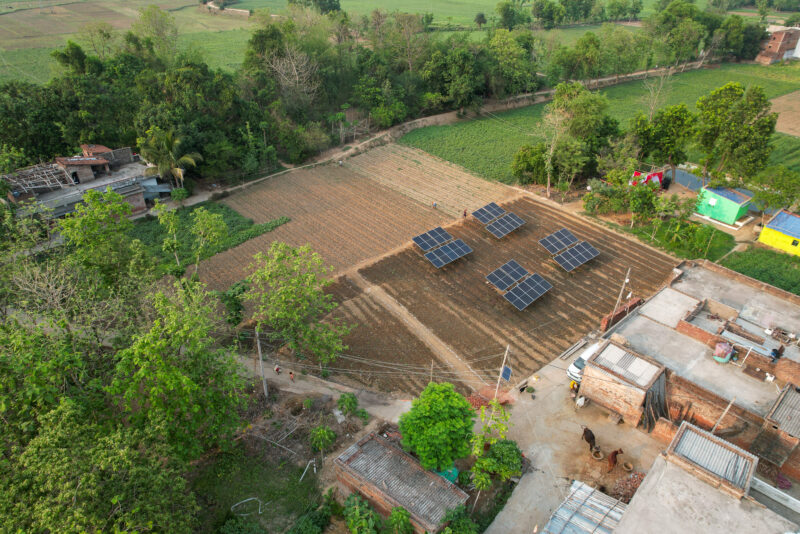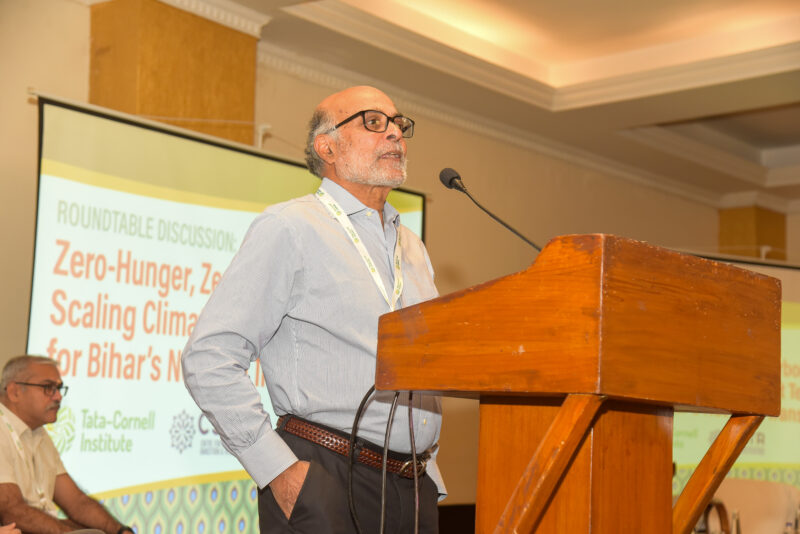Can Agrivoltaics Help Achieve Zero-Hunger, Zero-Carbon Food Systems?
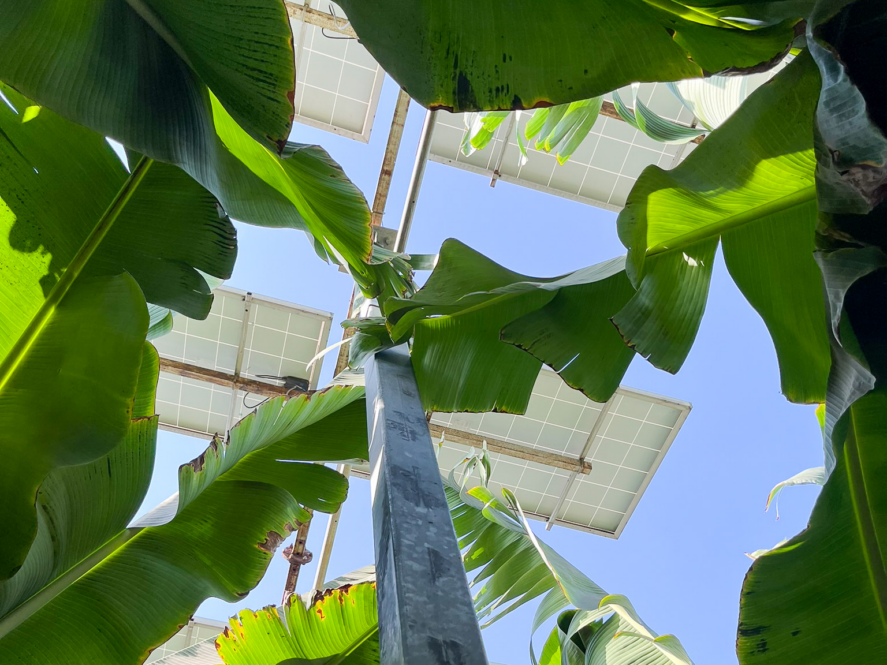
With a rising global population, demand for food and energy is increasing while the world seeks to move away from fossil fuel use. TCI’s Zero-Hunger, Zero-Carbon Food Systems project aims to reduce the climate impacts of food production in Bihar without compromising agricultural productivity. Some of the mitigating strategies include the reduction of methane emissions from rice and ruminant animals, as well as the net-positive benefit of solar energy.
In the first phase of the project, we identified three promising vehicles for reducing emissions while increasing rural household incomes: sex-sorted semen and anti-methanogenic feed supplements for livestock production, and alternate wetting and drying for rice production. Now, in the second phase of the project, we are testing the attitudes of small-scale farmers toward these technologies. We also added another encouraging option to the mix—agrivoltaics.
Why agrivoltaics?
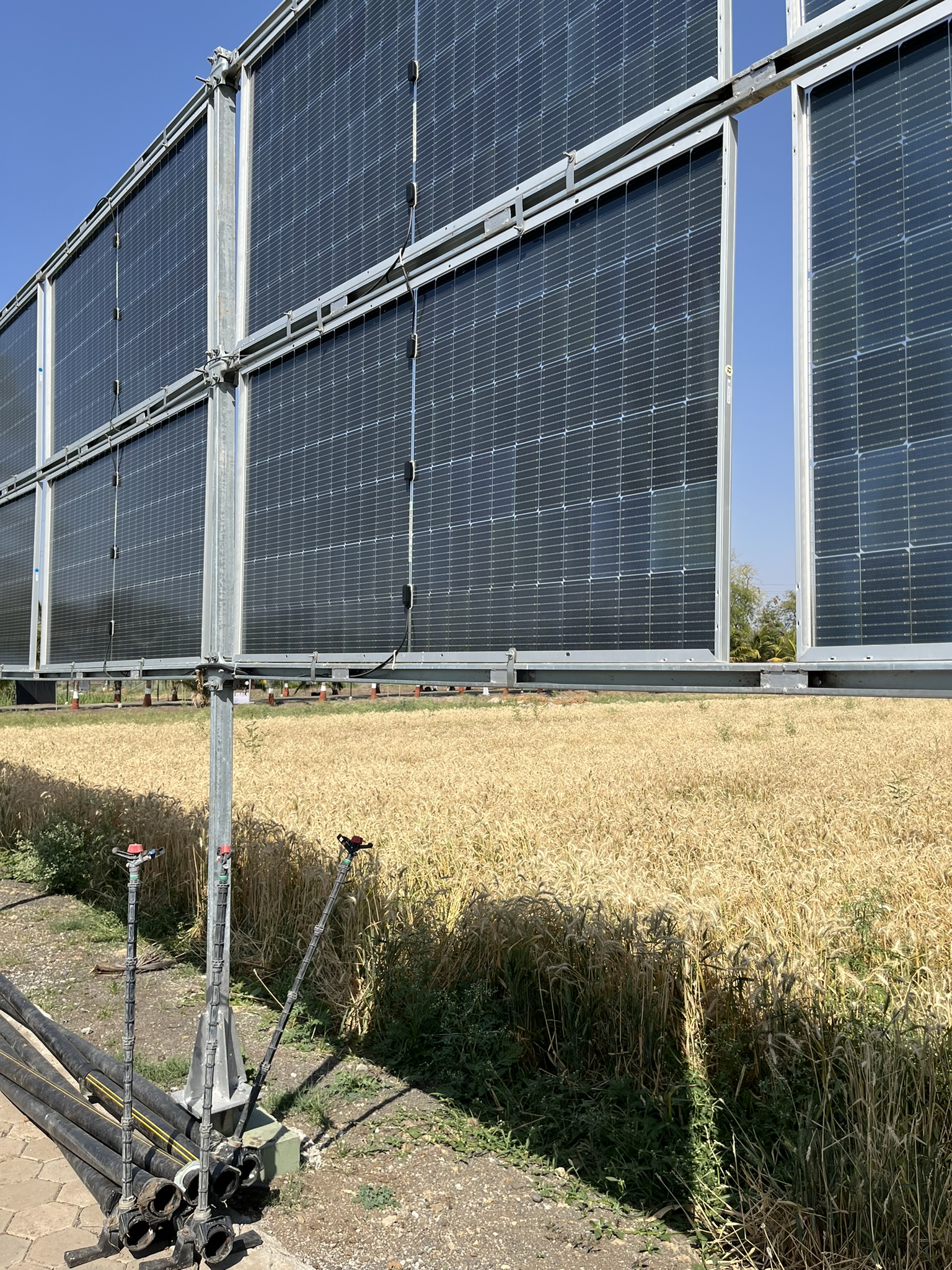
In agrivoltaics, solar panels are arranged in a context-specific manner that maximizes the potential of both crops and solar power. (Photo courtesy of Jain Irrigation)
Traditional “solar farms” installed on land compete with food production because limited agriculture is possible below solar panels, which are positioned very close to one another and very close to the ground. This may be suitable for unused lands, but in densely populated areas like northern India, it can present a real challenge. Landowners can and do lease their land to solar developers, which reduces the food supply and forces agricultural laborers to relocate and look for jobs elsewhere.
Agrivoltaics is a concept that allows the simultaneous production of agricultural products and solar power in the same area. This is possible by placing solar modules either above or next to crops or livestock. Arrangements of solar panels in agrivoltaics vary greatly and can be tailored for different uses. They can be elevated to different heights, positioned vertically or horizontally, use or not use tracking, and can be monofacial or bifacial. As a result, various fruits, vegetables, and field crops can be combined with solar panels, but the benefits are very location-specific. If applied appropriately, agrivoltaics can lead to improved food security and reduced dependence on fossil fuels.
Bihar is an ideal test area for this concept as it combines areas with very small landholdings and a high prevalence of undernutrition, coupled with an increasingly electrified rural economy that is mostly supported by fossil fuel combustion. We are in the process of designing a field-based study that will assess the potential impact of agrivoltaics and farmers’ receptiveness to the new technology.
Understanding the unknowns
As agrivoltaics is still a relatively new concept in India and globally, the TCI team started by identifying the unknowns surrounding its use. In collaboration with the India Agrivoltaics Alliance, we organized an event, “Agrivoltaics in India: State of play and research opportunities,” in which stakeholders from research institutions and the private sector presented their experiences and findings. Some of the main challenges discussed included:
- Power-purchase-agreement tariffs
- State government policies
- Competition with highly subsidized electricity for agriculture
- Appropriate scales of agrivoltaic installations
- Inclusion of small and marginal farmers
- Land availability
- Scalability
- Impact on crops
- Waste disposal
To address the India-specific knowledge gaps revealed by the meeting, TCI visited several agrivoltaics projects in India, including the Jain Irrigation Systems campus in Jalgaon, Maharashtra; Gujarat Industries Power Company Limited in Gujarat; and several other initiatives with innovative business models.
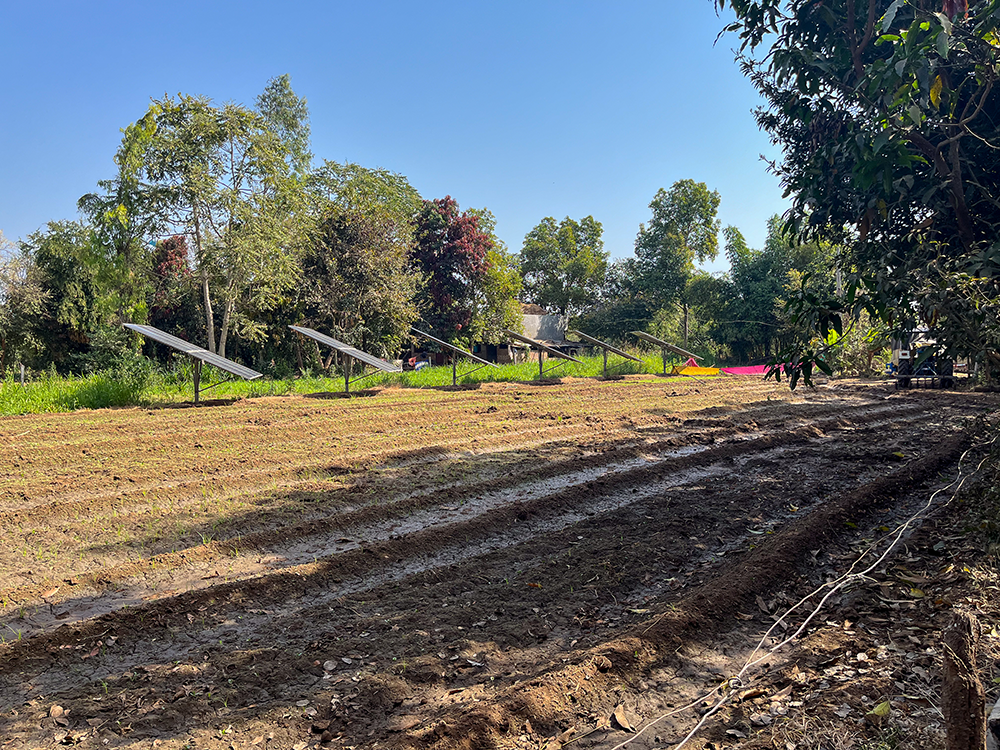
Each farmer from the Dhundi Solar Energy Producers’ Cooperative has a cluster of solar panels on their farmland and chooses how to use the power they produce. (Photo by TCI)
For example, the nine farmers from the Dhundi Solar Energy Producers’ Cooperative each operate a solar panel cluster and choose how to best use the power produced. This includes powering electric pumps to irrigate their own fields or sell water to their neighbors, as well as selling power to the local electrical utility. Each farmer has their own meter to monitor their individual contributions to the total power sold to the utility. This model is especially relevant to the Indian context because solar panels are often installed where they are infrequently used for irrigation pumping without a plan to use the excess power generated. As a result, the excess power is wasted.
The meeting and field visits enabled the TCI team to identify potential project partners among stakeholders in Bihar. The main stakeholders that we will be working with are farmers in southern Bihar, local NGOs (PRAN), solar site developers (Jain Irrigation Systems), the Bihar Renewable Energy Development Agency, the North and South Bihar Power Distribution Company Limited (DISCOMS), the Bihar Agriculture Department, the Bihar Electricity Regulatory Commission, and the Bihar State Pollution Control Board. Each plays a very important role in implementing agrivoltaics in the state.
Our activities also brought to the fore a number of factors that will prove crucial in the success or failure of agrivoltaics in Bihar:
Regulatory framework
Setting up agrivoltaics systems requires a good understanding of the current legal framework and the incentive structures. Regulations exist at the national and state levels, and different rules apply at different capacities in terms of power output. For example, Bihar currently has a very high threshold below which they do not procure electricity produced on land and which limits net-metering from small local solar systems.
Business models
There are several agrivoltaics business models (PDF). One assumes that farmers are owners of solar panels and decide themselves on power utilization. Another model assumes that farmers lease their land to a private company that sets up the solar modules and own the energy. The third model presents some combination of the two.
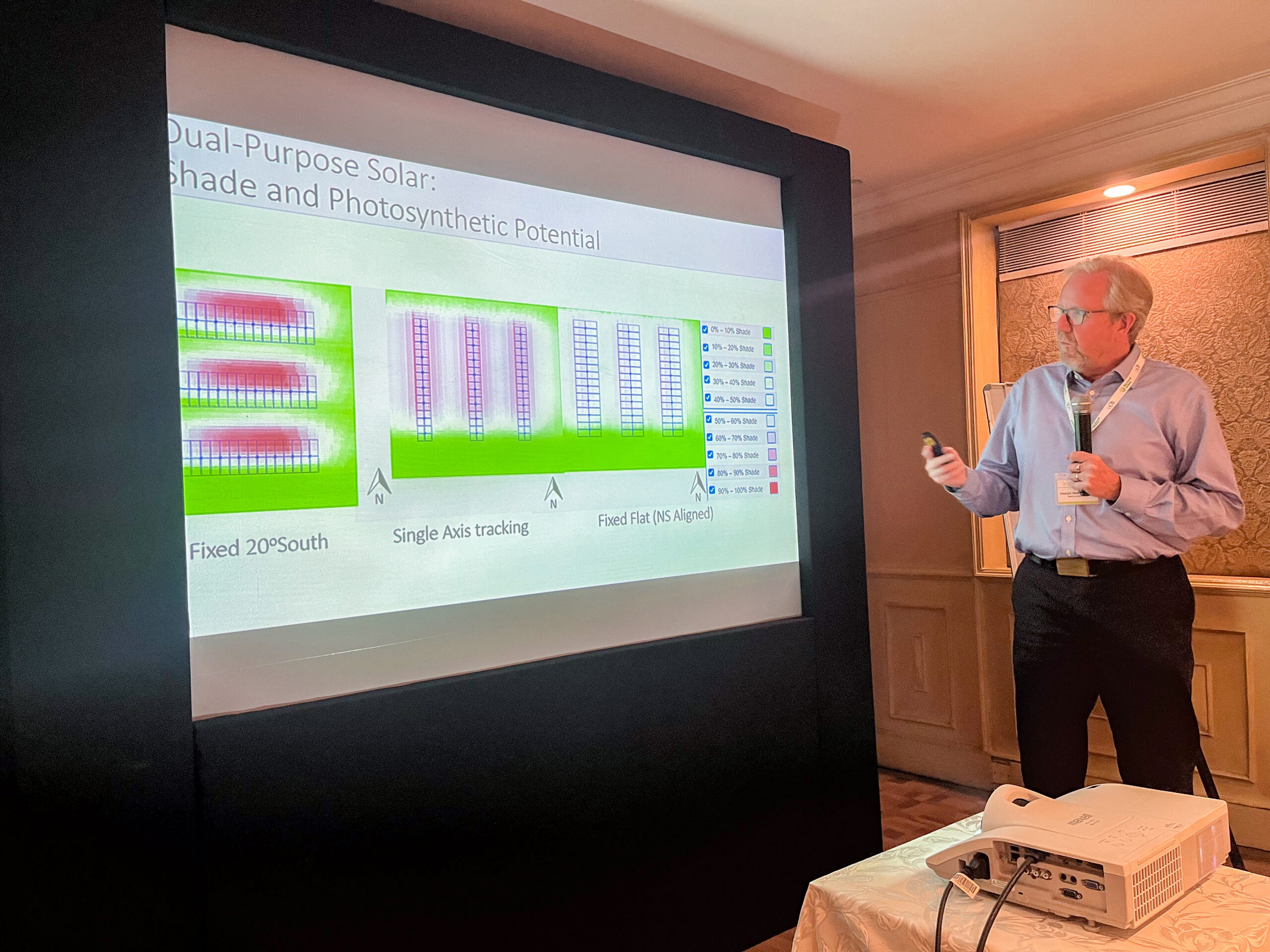
TCI Faculty Fellow Harold van Es delivers a presentation during a meeting with agrivoltaics stakeholders in Bihar. (Photo by TCI)
Economics
To assess the economic viability of the proposed model, the TCI team analyzed all of the costs and benefits with which it is associated. Materials and installation costs are straightforward, but the benefits are less clear. They ultimately depend on how the power will be utilized and what can be sold at what rate. The benefits appear to be a combination of:
- Cost savings from energy use for irrigation pumps (especially if diesel is exchanged for solar electric)
- Opportunities for growing higher-value crops year-round through efficient electric-powered irrigation systems and the benefits of shading during the hot and dry season
- The use of excess power by local businesses like a grain mills, refrigeration units, or EV vehicle power stations.
We aim to investigate the optimal installation size, threshold prices per kWh, and the positive and negative effects of current subsidies. We also want to better understand the entrepreneurial opportunities around new electricity uses.
Farmer mobilization
As the initial investment in agrivoltaics is prohibitively high for individual small and marginal farmers, some form of collective ownership may be required, as with Dhundi or water user associations. With each community that TCI engages with, we aim to consider its unique social dynamics and identify potential winners and losers from agrivoltaics in the community. Discussions need to be informative and realistic about the social and economic benefits while also promoting the opportunities around a sustainability-focused future.
Technical dimensions
The TCI team, together with PRAN and Jain Irrigation Systems, is aware that successful implementation of agrivoltaics requires investments beyond simply installing solar panels. Systems in our project are planned to include solar panel setups, irrigation pumps, borewells, drip irrigation installation, and power connections with either revenue-generating businesses or a power utility. Some elements can be monitored, maintained, and serviced by the farmers themselves, and they themselves may seek business opportunities for the low-cost excess power.
Externalities
Finally, we aim to be aware of the project’s externalities so that any environmental, economic, social or health-related issues caused by agrivoltaics can be mitigated.
The way forward
There are a lot of unknowns that we will try to convert to “knowns” by the end of this project. Introducing a new technology is a challenging task, while trying to do so among small and marginal farmers, who represent a majority of farmers in the region, is an even more difficult job.
The next “chapter” of our agrivoltaics story will mainly revolve around farmers and how we can best support them with logistical, technical, and institutional assistance. As the central stakeholders of Bihar’s agricultural sector, the farmers themselves must lead the way if efforts to lower agricultural emissions are to be successful.
Milorad Plavsic is the manager for strategic initiatives at TCI.
Harold van Es is a TCI faculty fellow and a professor of soil and water management in the Department of Crop and Soil Sciences at Cornell University.
Featured image: Solar panels are situated high above crops in a demonstration of agrivoltaics on the campus of Jain Irrigation Systems. (Photo courtesy of Jain Irrigation)




